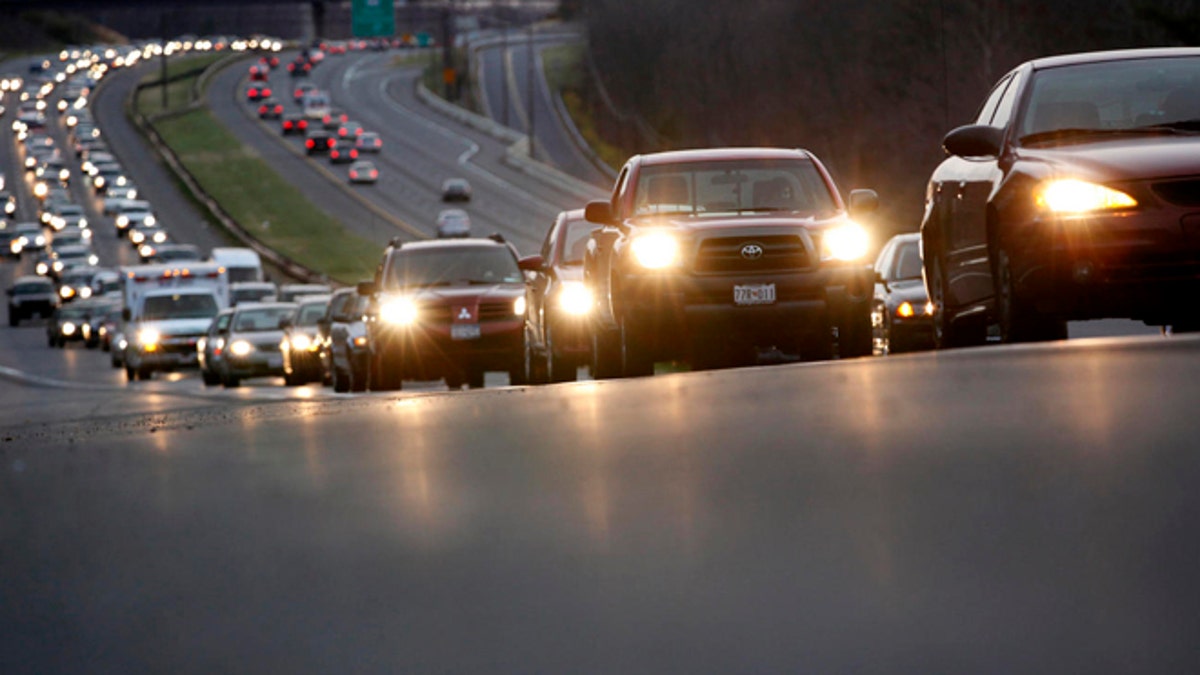
Traffic got you down? When not send a text message to the guy in front of you? (AP Photo/Carolyn Kaster)
The social network wants to friend your car. So get ready to start receiving a different kind of finger on the road.
At the New York International Auto Show, which kicks off this Friday, there will be a torrent of technology, but it isn't focused on mpg or "skid pad" performance. The new models are all about apps and Facebook friends.
In a high-tech tizzy, car makers will be busy touting new in-dash systems and remote services for drivers. There will be more touch-screen controls, such as the CUE system on Cadillac's jazzed up 2013 SRX crossover, and updated services, such as Mercedes-Benz's mbrace smartphone controls.
'The car is the last place in a connected world where people remain unconnected.'
Mass market manufacturers such as Ford, Honda, and Toyota are also touting more telematics: a combination of Internet-connected features for navigation, streaming music services, and apps from connected phones. (A lot of tech is aimed at safety as well, such as vibrating seats in Cadillac models that warn of impending collisions. Subaru will debut a pedestrian detection system, for example.)
While vehicles that automatically post Tweets have been tested in the past and many car companies have experimented with different kinds of apps and other social media features, a new service promises to catapult cars into the social media space by turning license plates into rolling e-mail and text addresses. It would effectively allow every driver to directly text or message every other driver by simply using their license plate number.
The appropriately named Bump Network lets people use a smartphone app to scan or enter a license plate number and then send the person a text or voice message. For the message to be received, both people have to sign up for Bump. The basic service is free, and the company's founder and CEO, Mitch Thrower, said it will reach people in the one remaining place where they are often still isolated.
"The car," Thrower said, "is the last place in a connected world where people remain unconnected." He thinks Bump has the potential to change people's behavior in disruptive ways.
For example, you could text a stranger that they left their lights on, or that they have a low tire or their car is being towed. Or better yet, "Hey beautiful. Saw you cruising on I-95. Want to hook up at the next rest stop?"
Of course, such connections could be "disruptive" in other ways. When someone cuts you off in traffic, a vitriolic message and a thumbs down could replace the traditional road-rage finger. Thrower doesn't think that would necessarily be a bad thing.
"If your e-mail was on the back of your car, you would drive differently," he suggested. But whether such social connectedness will make people kinder, gentler -- and more polite -- drivers remains to be seen.
Until now, Bump has been in a preview or beta mode with about 100,000 participants. In May, the company will release new software and services to try to appeal to the tens of millions of cars on the road.
A key component will be automatic license plate recognition. By culling video camera feeds, Bump cars can be automatically identified so that the driver can receive special notices, such as discounts for nearby restaurants. Parking garages may offer preferential treatment and automatic payment to Bump members, as well, which would mean never having to deal with a parking attendant again. For $39 a year, Bump will also offer a premium service that includes AAA-like services, such as free towing.
Bump may also offer an ersatz driver rating system, allowing members to "thumbs up" or "thumbs down" other drivers. However, the ratings wouldn't be made public to other Bump members unless the erratic operator allowed it. (I'm guessing only positive votes would end up being public.) Members also have the option of keeping their license private and blocking some or all incoming messages.
So are drivers ready to strip off another layer of privacy and put their cars in the clutches of the social network? Consider that Facebook is closing on a billion users -- and it doesn't even warn you about speed traps or flat tires.
Follow John R. Quain on Twitter @jqontech or find more tech coverage at J-Q.com.
